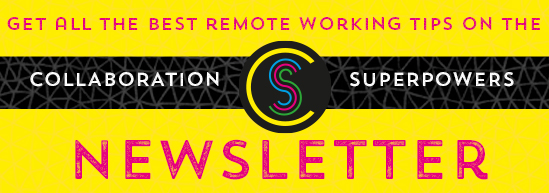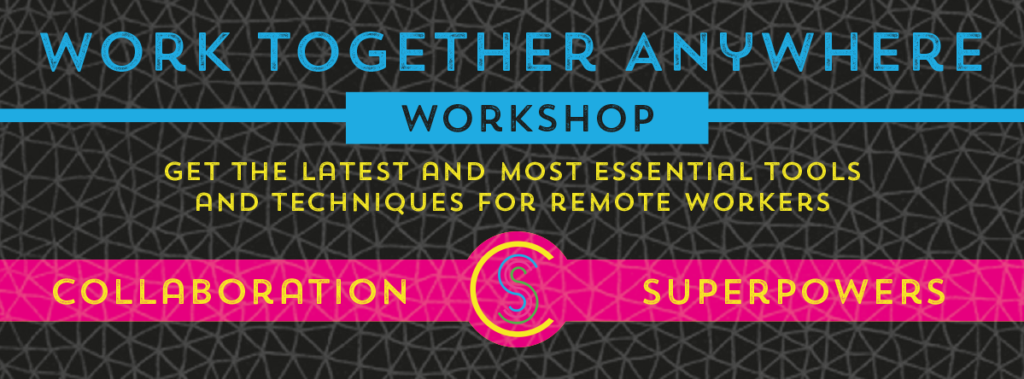In today’s world, we are increasingly trying to solve global problems. Diversity in the workplace helps us to increase innovations and problem solving and challenges our brains to think differently. Very obvious forms of diversity are gender, race, and nationality. But there’s also diversity in age, personality types, personal interests, etc. The best thing is to have a broad mix of all kinds of people on a team because they will then tend to attack the problems at various angles, all with their own biases.
Subscribe to the Collaboration Superpowers Podcast on iTunes or Stitcher.
Diversity on a remote team
With remote work, there are a few categories of people that can be added back into the workforce, such as stay-at-home parents or adults caring for their parents, and military spouses—who appreciate not having the family’s next deployment disrupt their own employment.
Another keen remote worker: retirees. Entrepreneur, speaker, and author Leslie Truex notes that “a lot of people are looking at how they can supplement their retirement. Or they are already retired or want to retire sooner—and know they need an income to do that.” Writer and employment expert Brie Reynolds agrees. She shares: “Both my parents are in retirement now. They want to stay active, but they don’t want to commute every day—and they don’t want all the office politics. What they do want is to apply the knowledge and the skills that they’ve learned across their lifetimes to something meaningful in retirement.”
There isn’t one way of working that accommodates everyone. Research shows that working with people who are different than us challenges the brain because we are really fooled by comfort. When we work with different people, we reexamine facts and we’re much more careful with information, we remain more objective, and we become aware of our own biases, just through working with other people that are different than we are.
Benefits of diversity on a remote team
- JUDGE ON OUTPUT. Remote working tends to be results-oriented, so it takes away some of the biases that we might have with visual forms of diversity. When people are only able to see our output, they can only judge us on our output, and all those other things disappear.
- CHAT CAN HELP. If we’re speaking mostly on asynchronous or written forms of communication, then accents go away. So when using chat forums, we sometimes communicate a little bit better.
- OUT OF SIGHT AS A BENEFIT. If we can’t see each other, another thing that goes away is the preconceptions that we may have based on how people dress. It’s been written that some people have been passed up for raises because of their flip-flop genes, casual wear in the office.
Working remotely gives us the benefit of hiring the best person for the job no matter where they are. Remote work forces us to judge people on their merits instead of their looks. Different ways of thinking give us more ideas, more innovation, and better solutions.
Podcast production by Podcast Monster
Graphic design by Alfred Boland
More Resources
- Why Diverse Teams Are Smarter – by Harvard Business Review
- How Remote Work Improves Diversity – by Scott Berkun
- Championing Diversity and Inclusion in Remote Work – by Remote.co
- The Diversity Bonus [YouTube] – by Scott Page
- The Diversity Bonus [Book] – by Scott Page
- Tech companies: make remote work part of your diversity and inclusion effort – by Margot Mazur
- Not Me, We. How Inclusive and Diverse Teams Represent the Future – by Atlassian
- From Conflict to Cooperation: Building Stronger Cross Cultural Teams – by Michael Henman
- The Age of Remote-First “Workplaces” – by Amir Salihefendic
- Getting remote-friendly – by Joe McGrath
Original transcript
Welcome to the Collaboration Superpowers podcast. My name is Lisette and I’m interviewing people and companies doing great things remotely. Hello, everybody, and welcome to episode 152. Today I want to talk about diversity on remote teams and how it can actually be a superpower. Now I’ve got to give credit to the person who inspired this podcast, and that is from my amazing colleague at Happy Melly Jennifer Riggins who is a marketing guru. So if you need marketing, SEO help, those kind of things, Jennifer Riggins is your gal. So it was Jennifer who inspired this podcast by sending me an article saying, “Hey, this is a great subject for your podcast.” So, Jen, thanks. Now we’ve all heard that diversity increases the innovation on all teams and that it’s good to have diversity in the workforce. Very obvious forms of diversity are gender, race, and nationality. Those are usually the ones that people think of first. But there are all kinds of other diversity as well. There’s age diversity, there are introverts versus extroverts. There are dog people versus cat people, mountain people versus beach people. You get the idea. The best thing is to have a broad mix of all kinds of people on team because they will then tend to attack the problems at various angles, all with their own biases. And that’s what the research says. It basically says that working with people who are different than us challenges the brain because we are really fooled by comfort. When we work with different people, we reexamine facts and we’re much more careful with information, we remain more objective, and we become aware of our own biases, just through working with other people that are different than we are. The benefits that remote working offers to having lots of different diversity on the team is that remote working tends to be results-oriented, so it takes away some of the biases that we might have with visual forms of diversity. When people can really only see our output, they can only judge us on our output, and all those other things fall away. Also, if we’re speaking mostly on asynchronous or written forms of communication, then accents can go away. So for using lots of chat, then sometimes it can communicate a little bit better. Though I find writing in another language much more difficult than speaking or understanding another language. So there’s sort of some back-and-forth error. Also, on most remote teams, people do use a lot of video. So yes, we communicate a lot via chat, and we also communicate a lot via video. So some of these visual things come back because we are using video.
Now if we can’t see each other, another thing that goes away is the biases that we may have based on how people dress. In fact, as I was researching articles about this, I was reading stories where some people were passed up for raises because of their flip-flop genes, casual wear in the office. So yeah, I can’t deny that there are any judgments there. The benefits that remote working has on diversity is that we can hire from anywhere, right? So we can get all kinds of diversity just based on we’re not at all limited by location.
And I really believe that while it’s great to have people together in the same office, I just think that the offices is not the most productive place for everyone at any given time. Productivity is always geared towards the lowest common denominator. Okay, I’m showing my biases here as usual.
I end today’s podcast by giving out a few more recommendations where you can talk about diversity and culture actually on a different team. So there are three podcasts I can recommend. I can recommend episode number 88 which is discover the culture on your virtual team. There’s also episode number 42 which is all about creating a team agreement which outlines your various ways of working. And I think when we have lots of diversity on a team, it’s really good to have a team agreement together to get some of those basic misunderstandings out of the way.
And the last podcast I can recommend is podcast 54 with Vanessa Shaw. She is an intercultural trainer and has lots to say about diversity and culture on virtual teams.
I know that was short and sweet and there’s a lot we can say about diversity, but in general, diversity helps us to increase innovations and problem-solving, and challenges our brains to think differently. And I think we can all use a little bit more of that. If you’d like to hear more stories about remote teams doing great things, then head over to the Collaboration Superpowers website. We’ve got all the interviews in video and podcast form as well as the transcripts for most of the podcast. It takes a little while to catch up with the transcripts, but most of them are there. And if you want to get all the best remote working tips delivered straight to your inbox, then just sign up on our newsletter, and every other week we’ll send you great tips, stories, techniques, all kinds of tools straight to the inbox of wherever you are. That’s collaborationsuperpowers.com/newsletter.
A huge thanks to our awesome podcast producer Nick Jaworski. He’s the one that makes us sound so pro. You can hire him to make you a star at podcastmonster.com.
And another big thanks to the dazzling designer Alfred Boland. You can hire him to make you look cool at bolanden.nl. All right, everybody, until next time, let’s go out and think about how we could get more diversity on our teams and be powerful.




